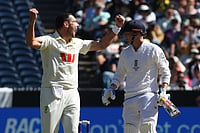A one-day innings is of 50 overs, or three-and-a-half hours. But how long do you need to concentrate? Just two seconds for every ball. You can relax between balls. Thus, you’re not all concentration for six hours. The idea is to raise the concentration levels at the right time.
Uncontrolled aggression: Against New Zealand in Taupo, Dravid got 123 off 123 balls and thus faced almost half of the overs. This means the strike didn’t rotate. That’s an area we should work on. They get out after a few dot balls trying to do the impossible. This is physical rather than mental aggression.
Physical aggression sometimes happens when you aren’t in control. But mental aggression is about always being in control. Ganguly was out to a physically aggressive shot. He normally hits it well when he goes over the top. Perhaps he was looking for a shorter square boundary. He fell for a trap. I’ve seen more people caught on the short boundary than the long boundary.
Mental aggression is about running three when there are only two, or two when there is one. Like Bevan or Dean Jones. We have to be good in identifying who in the opposition doesn’t have a good throw, and also keep the wind factor in mind.
Predictable bowling: The bowlers aren’t trying to bring in variations. I once saw Keith Miller get a leg before decision off a wrong ’un. Chris Broad, the England batsman, was once bowled by a leg break from Merv Hughes. But Indian bowlers tend to be predictable. Bowlers like Chris Harris are brilliant. Fast bowlers bowl far too short these days and we might have missed the greatest swing bowler in pursuit of tearaway pace. The last great swing bowler was Manoj Prabhakar. Kapil and he wrought havoc on the Australians in ’92. Kumble’s doing fine. When I realised he was trying to spin like Warne, I said you don’t need to. You have a wonderful record—on the strength of your skills. Stick to it. It’s amazing how even successful players succumb to pressure.
Negative fielding: Lack of confidence is partly to blame. When they’re circling around the ball, they’re a little negative. They don’t want to come in too hard and fumble. But if you circle the ball, the batsmen still get two. So, it’s better to attack and fumble and concede an extra run than to play safe and still concede that run. It requires mental concentration and aggression.
The other thing is energy level. When the ball is hit on the on-side and a throw comes in at the bowler’s end, the sweeper from the other side must come in to stop an overthrow. We’re now trying to put batsmen under pressure. When you’re fielding in the covers and the shot is hit to mid-off, if you come in hard the batsmen hesitate for that fraction of a second even if you don’t stop the ball.
(Aussie legend Simpson is a consultant to the Indian cricket team)


























